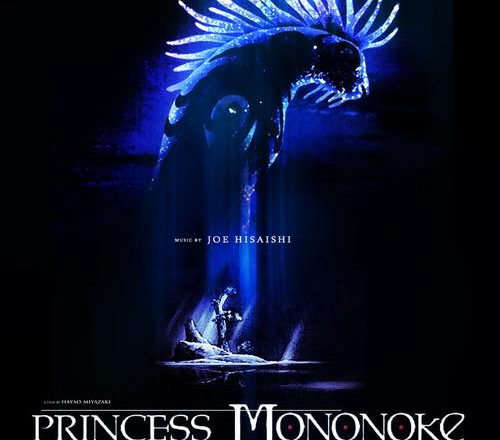Princess Mononoke (もののけ姫)
Director: Hayao Miyazaki
Written: Hayao Miyazaki
Country: Japan
Year: 1997
“Princess Mononoke” on Amazon.
Hayao Miyazaki and Studio Ghibli made Japanese animation (or anime) popular all around the world. Miyazaki tells complex stories though masterful imagery that encompasses both the Japanese anime style and the Disney fairytale style. I would assume this mixture, which is visually more acceptable for most Western viewers, was partially key to the success of his films outside Japan. It’s fortunate this formula works for a wide audience, as Miyazaki’s imaginary worlds are magic and have some serious messages in them. “Princess Mononoke” is my personal favorite, and very special to me. I first saw it on TV in my early teens, and was absolutely amazed. It was the first time I saw and realized the different narrative that some Asian films can have. In the Western world, we are used to the typical Good vs. Evil narratives (coming from deep Christian, Judean, and looking even earlier, Zoroastrian origin) that usually do not leave space for other emotions besides loving the heroes and despising the baddies. Therefore, Miyazaki’s approach, showing situations from different perspectives and not portraying anyone as absolutely evil, nor absolutely good, was like a fresh breath of air.

The story starts in the faraway peaceful Emishi Village, on a bright summer day. But there is something not right going on. The sounds of nature are ominous, the birds are silent and all the animals are gone as a shadow comes from the forest. A demonic power symbolically breaks a stone wall, the boundary between the human world and the forest world. The demon crawls towards the village, but is eventually shot by Prince Ashitaka. However, shooting a demon comes with a cost; and the demon’s corruption touched Ashitaka’s hand, cursing him. The wise woman of the village tells him that he will die from this curse, and that he has to leave the village forever. Ashitaka silently accepts his fate, and sets off riding to the West where the god-demon came from. He wants to find the origin of a metal ball that corrupted this god with hatred. There he finds a very unfamiliar world in the Muromachi period of Japan (Emishi people had different culture and lived separately from the ancestors of today’s Japanese). Eventually Ashitaka traces the origin of the cursed iron ball, which is actually a bullet. They are made in Irontown, a frontier city, where iron is being smelted. It is ruled by Lady Eboshi, who welcomes Ashitaka after he saves some of the villagers. He learns that villagers have been trying to cut down the forest to get ironsand for smelting iron. They had to fight the forest protector, a boar-god Nago, for it. In the battle, Nago is shot, and he becomes corrupt with anger and hatred. He turns into the demon that Ashitaka had to face. Though people cut down the trees, the animals are still fighting for it. Monkeys try to plant the trees every night, and the wolves, along with a human wolf princess (Mononoke hime – Princess of Spirits), attack the village in every way trying to kill Lady Eboshi. Ashitaka gets really angry with Eboshi, seeing that she wants to build more and better guns, to fight the gods as well as samurai (who attack the village to get the iron), thus spreading hatred. Eboshi expresses her sympathy for the curse:
That brainless pig. I’m the one he should have put the curse on, not you.
However, she does have her goals, and has her way of achieving them. Ashitaka learns about her good deeds too. Eboshi buys contracts in brothels, and brings women to Irontown to work for her. Even if the work is hard, all the women agree it is much better than being enslaved in brothels. She also employs and takes care of lepers, who are shoved away by everybody else in the world. She has to protect Irontown not only from forest gods, but also from samurai. Local Lord Asano has his eyes set on the iron and the land, as now it has been reclaimed from gods. To improve her position, she makes a deal with an opportunist, Jigo, to hunt down the Great Forest Spirit (Shishi-kami). There is a legend that the head of this spirit will make one immortal, and the emperor of Japan is seeking it. The plot gets quite complex. San, the Princess Mononoke, attacks the village, and tries to kill Lady Eboshi. Ashitaka stops them both, saves San, but gets injured in the process. San then decides not to kill him, and brings him to the Forest Spirit. Ashitaka is healed of his gun wound, but not his curse. He learns that the Boar Clan is going to attack the humans, but the humans are ready for this. Ashitaka desperately tries to make peace between the different sides, but eventually fails. The Great Forest Spirit dies. Its dead body grows a new forest, but a more human-friendly version, a tamed one. The Forest Gods are dead and power shifts to the human side. Lady Eboshi promises to build a new and better Irontown, which has been destroyed in the turmoil.

Although the era depicted is Muromahi period, it is not trying to bring an accurate image of medieval Japan. The goal was to show a clash between the natural world and the early stages of modern industrialized civilization. (Source: Princess Mononoke). However, there are a few details that show the historical characteristics of the period. First is the existence of such semi-autonomous places as Irontown. In earlier ages, before centralized government and Imperial Rule, there were clan settlements called uji. The Yamato uji was the clan where the imperial line came from, and the Yamato people became the majority, pushing away other ethnicities such as the Emishi (Ashitaka’s tribe). For centuries, landowners had to pay taxes to the central government. Later, however, land reform was introduced, encouraging people to take the wild lands and use them for agriculture.
By the twelfth century a great part of the agricultural land had been divided into tax-free private estates. (Source: “Japanese Today: Change and Continuity” by E. Reischauer).
his deprived the Emperor and aristocracy from a lot of income, and their power declined, while the power of local lords, daimyo, increased. This is why in the animation we see Lady Eboshi fighting Lord Asano, while the Emperor has no say in it. There is also a different image of samurai than Western audiences are used to seeing. They are shown as aggressive, and killing defenseless villagers, not the “code of honor” protectors of people as stereotypes indicate. This was the reality of local feudal lords fighting each other, and samurai were loyal to them. Commoners were just victims in the frequent feudal unrest. Ashitaka is not a part of this political system. The Emishi people were pushed away. It is mentioned in the beginning of the animation that their numbers are declining. They are very sorrowful, as now the last prince (Ashitaka) has to leave. This is a nuance of another topic encompassed by “Princess Mononoke,” the disappearance of other ethnicities in Japan.
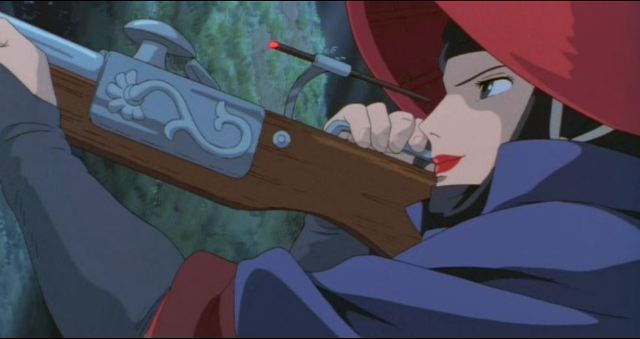
The other historical shift portrayed is the transition from the Stone Age to Iron Age.
Japan was centuries behind in the use of bronze and iron. (*Information “Japanese Today: Change and Continuity” by E. Reischauer).
Ashitaka is a product of the Stone Age, still using stone arrowheads. People he meets during the story already use iron. The changes from hunter-gatherer to agricultural societies, and from stone to iron use, were major shifts in human history when people started to manipulate nature for their own purposes. People from the Iron Age, like Lady Eboshi, do not fear nature, or even the gods. She has metal and gunpowder, and the human-produced metal is poisonous to the gods, and can kill them. The gods of nature can feel how the power balance is shifting towards the human side, and they are infuriated. The boar-god Okkoto expresses his frustration with a future vision:
Look at my tribe, Moro. We grow small, and we grow stupid. We will soon be nothing but squealing game that the humans hunt for their meat.
The gods are not shown as benevolent creatures either. They hate humans, fight with them, and they think that killing humans is the only way to protect the forest. Some even think of eating the humans and gaining their strength that way. The different animal clans are scattered, and do not cooperate with each other. They usually meet with a rather hostile sentiment. Harmony between humans and nature is also not idealized in the film. The animation implies that even before the conflict, nature was not a friendly place to people; rather it could be very dangerous and hostile. It was never like the fairytale ideal where animals and people would sing along together. In this context, humans trying to take control, and trying to have better living conditions, are not sinful acts per se. It is evil from the perspective of the gods, but the goal of humans is not to destroy nature. For humans it is about survival.
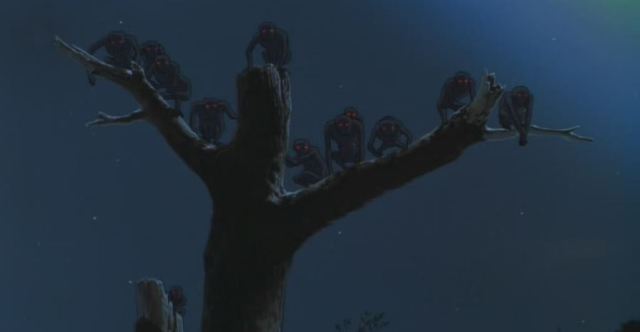
As it progresses, it is clear “Princess Mononoke” is an environmental film, but not the “evil humans destroying nature” type. Miyuzaki tried to show:
complexity in the relationship between humans and nature. (…) I didn’t want to be a story about a bad guy (Source: Nausicaa).
It is more about the loss of innocence and loss of the sanctity of nature. All pagan religions have been imagined through the natural environment. Such was the case with Shinto religion, folk beliefs in Japan that are still somewhat held today. Buddhism superseded Shintoism (although later it was also influenced by it, and merged with it in some ways). The film does not really show Buddhism, although it was in Japan at the depicted times. The only reference comes from the leper Osa:
Life is suffering. It is hard, the world is cursed. But still you find reasons to keep living.
The decline of nature and fall of gods is associated with the decline of Shinto beliefs. Therefore, “Princess Mononoke” encompasses the historical change of religious systems too.
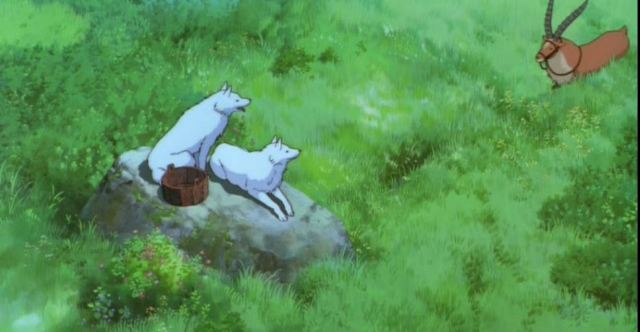
All of main characters of this film are outsiders from “normal” society. Ashitaka is thrown out from his village because of his curse, and is dead to them. He doesn’t belong to Japanese society either, so he “hides his face to show that he is a non-person” (Source: Nausicaa). San (Princess Mononoke), was abandoned by her parents and raised by the wolf-god Moro. Although Moro calls San her daughter, no other animals accept her as one of them. Humans do not see her as a person either, so she is also an outsider, stuck between two worlds. Lady Eboshi has a similar fate. Though she is called “Lady,” she is not from aristocratic origin. Her clothing indicates that she had been a prostitute, and viewers are left to assume what kind of hard life she had to endure to become such a willful Iron Lady that she is. Lady Eboshi shelters other outsiders too. The lepers explain that:
She [Lady Eboshi] is the only one who saw us as human beings. We are lepers. The world hates and fears us. But she took us in, and washed our rotting flesh and bandaged us.
The same goes for the working girls taken from brothels. Even the local town men despise them saying:
Women like that are disgraces. They defile the iron.
But because of Lady Eboshi, they are empowered, and can take control of their lives, which first means the control of their bodies. Miyuzaki himself sees Eboshi as a person of the 20st century, “she has a clear ideal and can take action” (Source: Nausicaa). Ashitaka, as an outsider of the whole conflict and system can see and sympathize with all sides. That is why we see the story through his eyes.
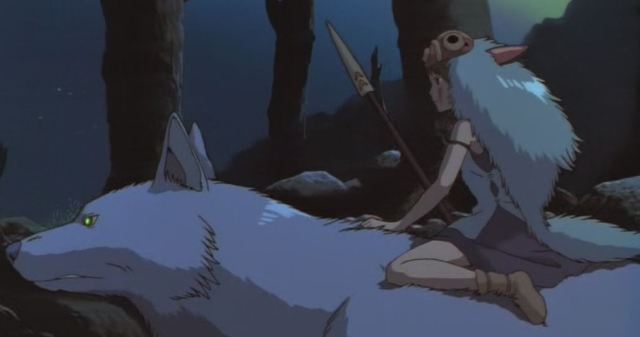
Even not knowing all these nuances and complexities of the historical-religious context, Miyuzaki’s magical world of “Princess Mononoke” is an experience not to be missed; and the most amazing part for me is how he manages to explore such sensitive topics without blaming or pointing fingers. “It’s not bad people who are destroying the forests.”
- 24 Asian Movies and TV Shows to Watch on Netflix (Updated) - April 6, 2021
- Permission to Exist – a documentary on South Korea’s education system and mental health awareness among Korean teens - December 15, 2020
- Luang Prabang Film Festival Goes Online - November 2, 2020
